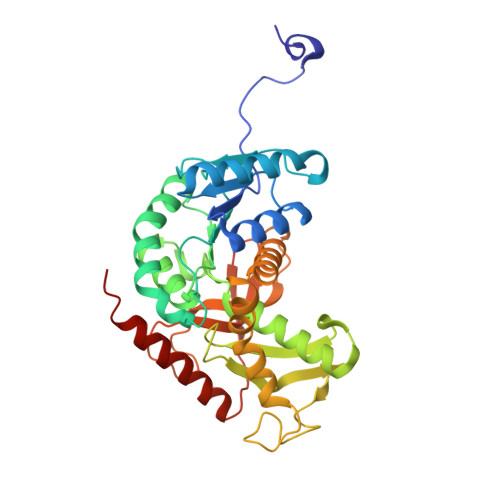Identification and Activity of a Series of Azole-based Compounds with Lactate Dehydrogenase-directed Anti-malarial Activity.
Cameron, A., Read, J., Tranter, R., Winter, V.J., Sessions, R.B., Brady, R.L., Vivas, L., Easton, A., Kendrick, H., Croft, S.L., Barros, D., Lavandera, J.L., Martin, J.J., Risco, F., Garcia-Ochoa, S., Gamo, F.J., Sanz, L., Leon, L., Ruiz, J.R., Gabarro, R., Mallo, A., De Las Heras, F.G.(2004) J Biol Chem 279: 31429-31439
- PubMed: 15117937
- DOI: https://doi.org/10.1074/jbc.M402433200
- Primary Citation of Related Structures:
1T24, 1T25, 1T26, 1T2C, 1T2D, 1T2E, 1T2F - PubMed Abstract:
Plasmodium falciparum, the causative agent of malaria, relies extensively on glycolysis coupled with homolactic fermentation during its blood-borne stages for energy production. Selective inhibitors of the parasite lactate dehydrogenase (LDH), central to NAD(+) regeneration, therefore potentially provide a route to new antimalarial drugs directed against a novel molecular target. A series of heterocyclic, azole-based compounds are described that preferentially inhibit P. falciparum LDH at sub-micromolar concentrations, typically at concentrations about 100-fold lower than required for human lactate dehydrogenase inhibition. Crystal structures show these competitive inhibitors form a network of interactions with amino acids within the active site of the enzyme, stacking alongside the nicotinamide ring of the NAD(+) cofactor. These compounds display modest activity against parasitized erythrocytes, including parasite strains with known resistance to existing anti-malarials and against Plasmodium berghei in BALB/c mice. Initial toxicity data suggest the azole derivatives have generally low cytotoxicity, and preliminary pharmoco-kinetic data show favorable bioavailability and circulation times. These encouraging results suggest that further enhancement of these structures may yield candidates suitable for consideration as new therapeutics for the treatment of malaria. In combination these studies also provide strong support for the validity of targeting the Plasmodium glycolytic pathway and, in particular, LDH in the search for novel anti-malarials.
Organizational Affiliation:
Department of Biochemistry and Molecular Recognition Centre, University of Bristol, Bristol BS8 1TD, United Kingdom.
















